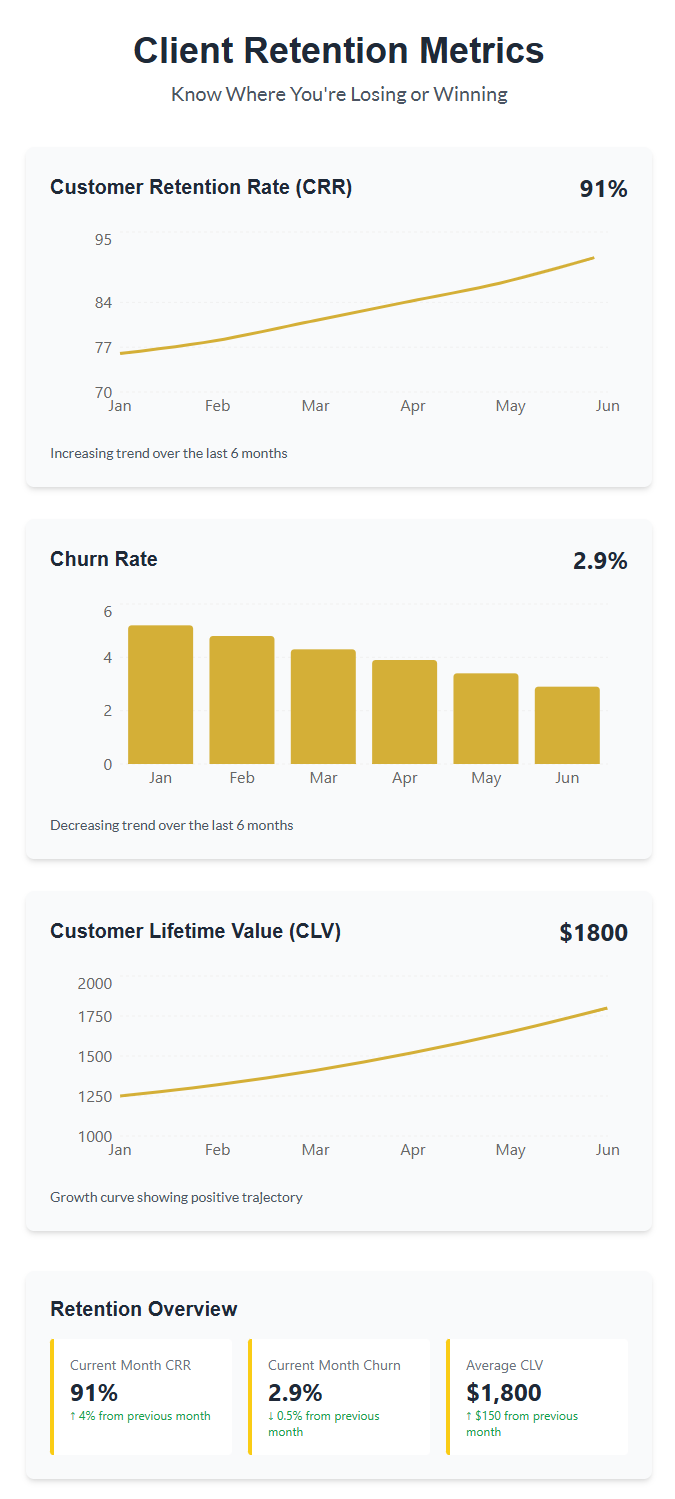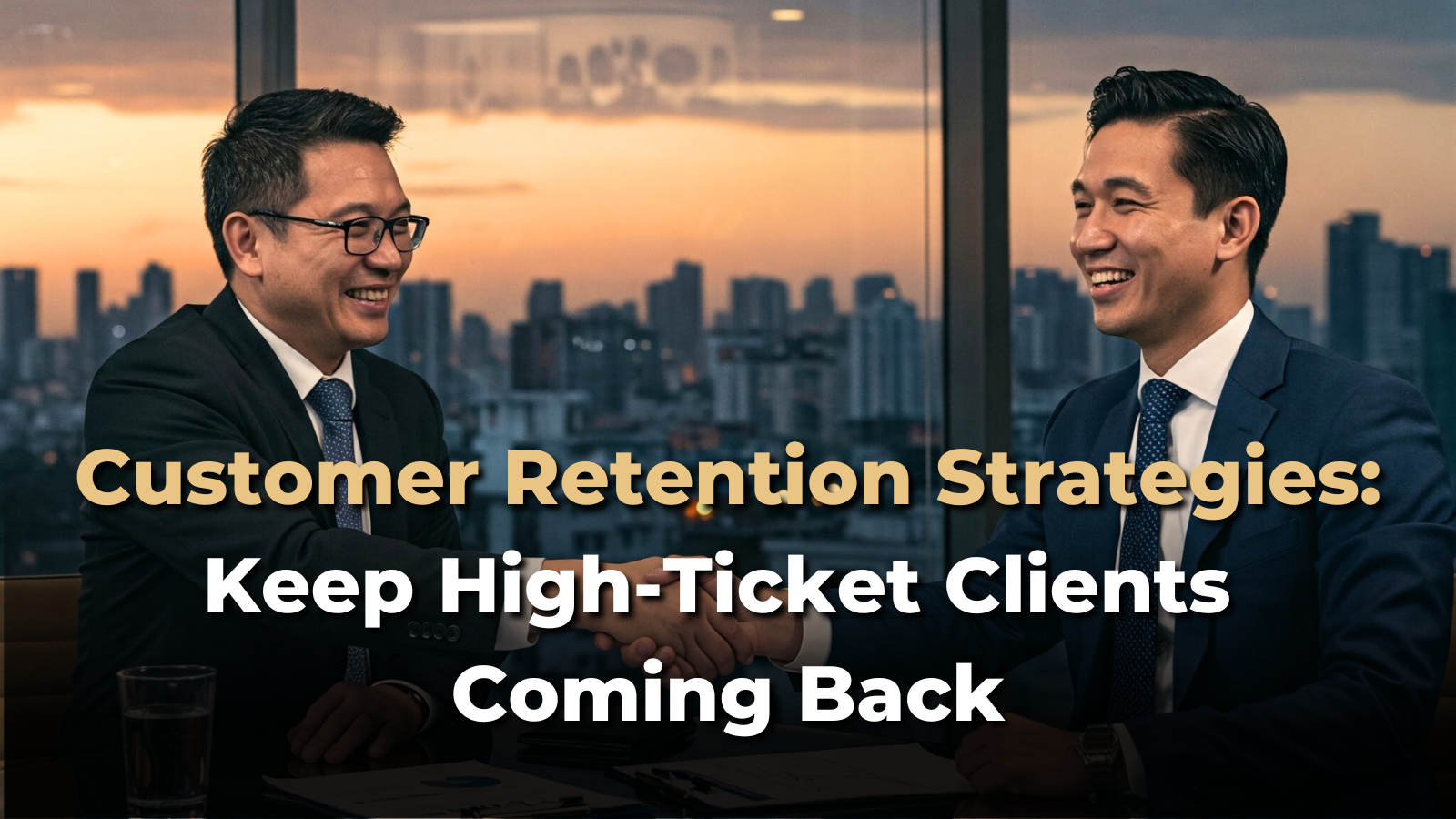Most businesses are addicted to chasing new clients.
They spend thousands on ads, hire expensive sales teams, and burn through leads—constantly searching for their next deal.
But the real money?
Table of Content
- Customer Retention Strategies That Keep High-Ticket Clients Coming Back
- What Is Customer Retention (And Why It’s Critical for High-Ticket Business Growth)?
- What Customer Retention Really Means (And Why It’s a Profit Multiplier)
- Benefits of Customer Retention
- Customer Retention vs. Customer Acquisition: Where Should You Focus?
- Key Metrics to Measure Customer Retention Success
- Rule #1: Treat Your High-Ticket Clients Like VIPs
- Rule #2: Keep Clients Invested (Psychologically & Financially)
- Rule #3: Make Leaving Feel Like a Huge Loss
- Rule #4: Turn Clients into Brand Ambassadors
- Creating a Unified Customer View (So You Never Miss a Retention Opportunity Again)
- How to Measure & Improve Customer Retention Over Time
- The Retention Strategy Checklist (Action Plan)
- Retention = Bigger Profits
- Want to Build a Business Where Clients Stay for Years?
It’s in keeping clients you already have.
If you know how to retain high-ticket clients, you won’t just increase revenue—you’ll build a business that scales effortlessly. This makes customer retention important it not only prevents the loss of customers but also reflects the quality of your product and service.
Here’s why:
- Retaining a client is 5X cheaper than acquiring new ones.
- Loyal clients spend 10X more over time.
- Satisfied clients become your best brand ambassadors.
Yet, most entrepreneurs make the critical mistake by treating every client the same.
High-ticket clients expect more. And if they don’t get it? They’ll leave fast.
Let’s dive in.
What Is Customer Retention (And Why It’s Critical for High-Ticket Business Growth)?

Customer retention refers to keeping existing customers engaged, satisfied, and keep purchasing.
Yet most businesses assume retention just “happens” if the product is good enough.
Wrong.
Retention must be engineered—especially for high-ticket clients.
What Customer Retention Really Means (And Why It’s a Profit Multiplier)
Customer retention isn’t just about keeping clients on your list.
It’s about turning first-time buyers into lifelong customers who spend more, refer others, and become walking testimonials for your brand.
Here’s the truth:
Acquiring new customers is expensive.
Retaining them? That’s where the real profit is made.
High-ticket clients who stay longer don’t just buy more—they trust you more. And that trust turns into:
✔ Repeat purchases
✔ Higher lifetime value
✔ Premium referrals (without you spending another cent on ads)
When done right, retention becomes your most powerful growth strategy.
You’re not just closing more deals—you’re building a client base that funds your business for years.
So if you’re still focused only on acquisition?
You’re leaving massive revenue on the table.
Benefits of Customer Retention
There are several compelling benefits of customer retention that can significantly impact a business’s success:
- Increased Revenue: Loyal customers are more likely to make repeat purchases, leading to a steady stream of revenue. This consistent income can help stabilize the business and provide a reliable financial foundation.
- Improved Customer Satisfaction: Implementing effective customer retention strategies can enhance customer satisfaction. Satisfied customers are more likely to share their positive experiences, which can boost your brand’s reputation and attract new customers.
- Reduced Churn: By focusing on customer retention, businesses can reduce churn rates. Lower churn means fewer resources spent on acquiring new customers to replace those who leave, resulting in cost savings.
- Increased Customer Lifetime Value: Loyal customers have a higher customer lifetime value, meaning they contribute more revenue over their relationship with the business. This increased value can drive long-term growth and profitability.
- Competitive Advantage: Businesses that prioritize customer retention can gain a competitive edge. Loyal customers are less likely to switch to competitors, and their positive word-of-mouth can attract new customers, further strengthening the business’s market position.
Customer Retention vs. Customer Acquisition: Where Should You Focus?
Most businesses pour 80% of their efforts into customer acquisition while ignoring retention.
Big mistake.
Consider this:
- New customer acquisition costs 5X more than retaining a loyal customer.
- A 5% increase in customer retention rates can boost profits by 25%–95% (Harvard Business Review).
- Repeat customers spend 67% more than first-time buyers.
Translation? The longer a client stays, the more valuable they become.
If your business only focuses on closing but not keeping them, you’re burning money.
Key Metrics to Measure Customer Retention Success
If you’re tracking the right numbers, you’ll know exactly how much money you’re losing.
Here are the critical customer retention metrics to watch:
- Customer Retention Rate – What percentage of clients stay over time?
- Customer Churn Rate – How many clients leave?
- Customer Lifetime Value (CLV) – How much revenue does a client generate over their lifetime?
- Repeat Purchase Rate – How often do clients return to buy more?
If you’re not tracking these, you’re flying blind—and high-ticket clients are leaving without you noticing.
Now that you understand why retention is critical, let’s move to the first rule of keeping high-ticket clients engaged.
Rule #1: Treat Your High-Ticket Clients Like VIPs
Want to know the #1 reason high-ticket clients leave?
They stop feeling special.
Think about it—why do people pay $10,000 for a mastermind instead of buying a $50 course?
It’s not just the information.
They want exclusivity. They want priority access. They want status.
If your customer retention strategy doesn’t reinforce their VIP status, they’ll look for it somewhere else.
If you treat them like everyone else, they won’t stay.
If they ever feel like they’re just another number in your CRM, you’ll lose them.
Actionable Strategies to Make Clients Feel Like VIPs
1. Exclusive Perks
People don’t just want great service—they want access to something others can’t get.
Private Training – Exclusive live sessions or invite-only webinars.
Behind-the-Scenes Content – Insider updates that make them feel like an insider in your business.
Members-Only Events – High-ticket clients get VIP invites to elite networking experiences.
Case Study: One business coach doubled retention by launching an exclusive “Inner Circle” for premium clients.
2. Priority Support & White-Glove Service
When a high-ticket client needs something, they expect a faster, smoother experience.
✔ Dedicated Account Managers – One point of contact for personalized attention.
✔ Faster Response Times – VIP clients skip the line and get immediate support.
✔ Done-for-You Upgrades – Instead of giving them DIY courses, offer done-for-you solutions.
Example: Think about how luxury hotels treat VIP guests—they get priority check-in, personal concierge service, and custom experiences. Your customer retention strategy should do the same.
3. Surprise Upgrades & Loyalty Rewards
Unexpected bonuses and perks create an emotional connection that keeps them engaged, encouraging customers to return and stay loyal.
Retention Tactics That Work:
- Milestone Bonuses – Special rewards after 6 months, 12 months, or anniversaries.
- Unexpected Check-Ins – A personal message just to say thank you.
- Invite-Only Upgrades – Exclusive “client-only” enhancements that make them feel valued.

The Bottom Line: VIP Treatment = Long-Term Retention
High-ticket clients aren’t looking for deals—but for experiences.
The more they feel like they’re in an elite club, the longer they’ll stay and the more they’ll spend.

Rule #2: Keep Clients Invested (Psychologically & Financially)
Most businesses lose high-ticket clients for one simple reason:
They let engagement drop.
It’s not about price.
It’s not about competition.
If your client stops using your offer, they’ll convince themselves it’s not worth keeping.
Once they start questioning the value:
Game over.
That’s why you must reaffirm their investment—both financially and psychologically.
Here’s how.
The “Engagement Drop” Effect (Why Clients Leave)
Ever notice how most client churn happens in the first months?
That’s because excitement fades.
Think about gym memberships:
✔ In the first month, people are excited.
✔ By month three, they skip a few workouts.
✔ By month six? Most cancel.
Your high-ticket offer works the same way.
If clients aren’t seeing results, they’ll lose interest.
If they don’t feel connected, they’ll move on.
So make sure they never disengage.
Retention Tactics That Keep Clients Committed
1. Deliver Quick Wins (The First 30 Days Matter Most)
The longer a client waits for results, the more likely they are to leave.
Your retention strategy must focus on getting them “quick wins” fast.
Example: If you run a high-ticket coaching program…
- Instead of saying: “You’ll see results in 3–6 months”
- Help them achieve a small but meaningful breakthrough within the first 30 days to encourage customers to stay committed.

2. Tie Their Identity to Your Offer
Want loyal customers who never leave?
Make your offer part of their identity.
Example:
- Tesla owners don’t just drive cars—they’re part of a movement.
- Apple fans don’t just use tech—they’re Apple people.
- CrossFit isn’t just a gym—it’s a lifestyle.
If your high-ticket clients see your offer as a service, they’ll leave at the first opportunity.
But if your offer becomes part of who they are? They’ll never leave.
Action Step:
- Create a strong brand message that aligns with your client’s goals & self-image.
- Reinforce that your clients are part of an elite, high-level group.
- Showcase testimonials & success stories to solidify the idea that “people like them” are part of your program.
3. Introduce the Next-Level Offer (Before They Think of Leaving)
If you don’t give clients a reason to stay, they’ll go looking for it elsewhere.
Retention Tactic:✔ Before their engagement drops, introduce a next-level offer that keeps them moving forward. ✔ Examples:
- Coaching clients? VIP mentorship.
- Membership site? Exclusive “Inner Circle” upgrade.
- Service-based business? Higher-tier personalized solutions.
Why This Works:
- Instead of wondering “What’s next?”, your clients know the new goal they’ll achieve with you, which encourages customers to stay engaged and loyal.
- More engagement = more retention = more revenue.

Keep Clients Engaged, or Lose Them
High-ticket clients stay when they feel progress.
If engagement drops, retention drops.
Your job?
✔ Deliver quick wins so clients feel immediate success.
✔ Make your offer part of their identity so they never want to leave.
✔ Always have a next-level offer ready before they start looking elsewhere.

Rule #3: Make Leaving Feel Like a Huge Loss
Most businesses beg clients to stay.
That’s weak.
High-ticket clients don’t respond to desperation—they respond to value.
Make leaving feel like a massive loss.
If clients feel like they’re walking away from something too good to lose, they’ll stay.
Here’s how to engineer a retention strategy that makes staying the only logical choice.
Why Most Businesses Fail at Retention (And Lose Millions)
Most companies think retention is about better service or lower prices.
High-ticket clients don’t care about discounts—they care what they’re getting from you that they CAN’T get anywhere else.
When your offer is replaceable, clients start looking for alternatives.
And when your offer feels irreplaceable?
Clients hesitate before leaving—because they know they won’t find the same value elsewhere.
Retention Tactics That Create “Switching Pain”
1. Build a Strong Community (Clients Leave Services, Not People)
FACT:
Clients will cancel a subscription—but they won’t abandon a tribe they feel connected to.
If you build a strong community, leaving means losing more than just your service.
How to Make This Work:
Create a mastermind where clients network with like-minded individuals.
Host VIP-only events that make clients feel like part of something bigger.
Introduce client collaboration opportunities (joint ventures, partnerships, referrals).
Example:
Think about elite masterminds—people stay for years because the connections are too valuable to leave behind.
2. Offer “Too Good to Leave” Perks
If a client is thinking about leaving, they need a reason to stay.
Retention-based perks keep clients engaged for the long haul.
Retention Tactics That Work:
✔ Milestone Rewards – Give clients special bonuses at 6 months, 12 months, and beyond.
✔ Locked-In Pricing – If they cancel, they lose their exclusive rate.
✔ Access to Exclusive Content or Calls – Keep certain content to long-term members.
Example:
Imagine paying $5,000/year for a membership—but knowing that if you cancel, the renewal price jumps to $10,000.
Would you leave? Probably not.
3. Frame Retention as an Investment, Not an Expense
High-ticket clients think in terms of ROI (Return on Investment).
If they feel like they’re getting more than they’re spending, they’ll stay for years.
How to Reinforce This Mindset:
- Show them what they’re gaining every month.
- Use language that reinforces investment.
- Remind them of how much they’ve already gained—so quitting feels like throwing away progress.
Case Study: A consultant who retained 80% of his clients by shifting from a “monthly payment” model to an “investment in long-term success” message.
Make Leaving Feel Too Costly
If quitting feels like losing too much, clients won’t leave.
Your job?
✔ Build a community so strong that leaving means losing relationships.
✔ Offer perks that disappear if they cancel.
✔ Frame your service as an investment, so quitting feels like losing momentum.

Rule #4: Turn Clients into Brand Ambassadors
Want to know the fastest way to keep high-ticket clients for years?
Make them your biggest advocates.
When clients start recommending you to others, something powerful happens:
✔ They reinforce their commitment to your business.
✔ They feel emotionally invested in your success.
✔ They start thinking: “If I’m sending people here, I should probably stay in it myself.”
Retention Secret:
When clients promote your brand, they become part of it—and people don’t abandon what they help build.
Why High-Ticket Clients Become Your Best Marketers
FACT:
Most businesses rely on paid advertising to get new clients… but word-of-mouth referrals convert 10X better.
Why? Because trust is already built in.
When a client refers someone, they aren’t just bringing you a lead…
They’re vouching for your brand.
The more they refer, the more they feel connected to your success—which makes them less likely to leave.
How to Turn Clients Into Ambassadors
1. Create a Referral Program That Actually Works
Most businesses get referrals wrong.
They offer weak incentives and wonder why clients don’t promote them.
What High-Ticket Clients Actually Want:
✔ Exclusive Perks – VIP experiences, private events, or premium upgrades.
✔ Cash Incentives – % of deal closed (if relevant to your business).
✔ Recognition & Status – Publicly highlight top referrers as elite members.
Best Referral Program Tactics:
- Offer private coaching or one-on-one calls as a reward.
- Give referrers exclusive early access to new offers.
- Run leaderboard-style challenges for top ambassadors.
Example: Imagine if clients who referred 3+ people got a free 30-minute private strategy session with you. That’s high-value—and high-retention.
2. Feature Client Success Stories (Make Them the Star)
People stay loyal to brands that celebrate them.
When clients see their success tied to your program, they feel proud to stay.
Seeing other clients winning motivates them to stay engaged and get better results.

3. Give Clients Leadership Roles (Elevate Their Status)
One of the biggest reasons high-ticket clients leave?
They feel like they’ve “outgrown” your program.
Solution? Give them a bigger role.
✔ Invite top clients to become mentors, guest speakers, or community leaders.
✔ Let them host Q&A calls or contribute insights to your program.
Why This Works:
- It keeps them engaged & feeling valued.
- It shifts them from student to leader—which makes them less likely to leave.
Case Study: One business reduced churn by 45% by turning top clients into brand ambassadors.
Make Clients Feel Like a Vital Part of Your Brand
Retention isn’t just about keeping clients—it’s about making them want to stay.
Your job?
✔ Create a referral program that actually excites high-ticket clients.
✔ Feature their success stories so they feel like a key part of your brand.
✔ Give them leadership roles, so they stay engaged at a higher level.

Creating a Unified Customer View (So You Never Miss a Retention Opportunity Again)
Most businesses lose clients not because the offer is bad—but because they don’t actually understand their customers.
That’s where a unified customer view becomes a game-changer.
What does that mean?
It means pulling data from every touchpoint—your CRM, customer feedback, purchase history, even social media interactions—and creating a complete profile of each client.
Because here’s the truth:
You can’t retain what you don’t understand.
When you know exactly:
- What your high-ticket clients want
- How they behave
- Where they’re getting stuck
- And what makes them buy again…
You can deliver a level of personalized service that makes your competitors look generic.
Example: Instead of blasting the same email to everyone, you send tailored messages based on what stage they’re in—and what offer they’ve engaged with most.
That’s not just better service.
That’s relationship management at the elite level.
A unified customer view helps you:
- Anticipate client needs
- Personalize your retention strategy
- Deliver exceptional customer service
- And keep your most valuable clients loyal for the long haul
The better you know your clients, the easier it is to keep them coming back.
Integrating Customer Data: The Overlooked Key to Client Retention
Want to know why most businesses provide mediocre support—even when they have great teams?
Because they’re operating with fragmented data.
Client bought from your webinar? That info lives in your payment processor.
Reached out for help? That’s buried in a help desk ticket.
Attended your last VIP event? That’s in someone’s spreadsheet.
If your team can’t see the full picture, they can’t deliver the full experience.
And high-ticket clients?
They expect precision. Speed. Personalization.
Here’s how integrating customer data gives you the unfair advantage:
1. Personalized Support That Feels Elite
When your team has access to the full client journey, they can offer support that feels tailored, not templated.
- Know what offer they purchased.
- Know what results they’re aiming for.
- Know exactly where they’re stuck—before they even say it.
That’s how you turn average support into a VIP experience.
And that’s how you retain high-ticket clients.
2. Lightning-Fast Response Times
Integrated data means no bouncing between tools, no guessing games, no delays.
Your team can pull up everything in one click—and resolve issues before they become complaints.
Faster support = happier clients = higher retention.
Simple math.
3. A Seamless Experience That Clients Remember
When you understand the complete customer journey, you can spot pain points, gaps, and drop-off moments—and fix them before clients churn.
This is how elite brands stay one step ahead:
✔ Predict problems.
✔ Deliver proactive support.
✔ Make every interaction feel intentional and on-brand.
Bottom line?
If your goal is to retain premium clients, stop guessing—and start integrating.
Because if your team doesn’t know your clients, someone else will.
How to Measure & Improve Customer Retention Over Time
If you’re not tracking the right numbers, you have no idea how much money you’re leaving on the table.
FACT: Most businesses don’t lose clients overnight—they lose them over time… and never see it coming.
That’s why measuring customer retention is crucial.
If you track the right metrics, you’ll know exactly where your retention strategy is working—and where you’re losing clients.
Key Metrics You Must Track
Want to increase customer retention? Start by tracking these numbers.
1. Customer Retention Rate (CRR)
The percentage of existing customers who stay over a specific period.
Formula:
[(Customers at End of Period – New Customers) / Customers at Start of Period] x 100
Example:
- Start of the year: 100 clients
- New clients acquired: 30
- End of the year: 110 clients
- Retention Rate = 80%
Industry Benchmark:
- A good customer retention rate for high-ticket businesses = 70–90%
2. Customer Churn Rate
The percentage of clients who leave during a specific period.
Formula:
(Customers Lost / Customers at Start) x 100
Example:
- Start of the year: 100 clients
- Clients lost: 20
- Churn Rate = 20%
Why It Matters:
- A high churn rate = low retention, meaning your business is constantly replacing lost clients.
3. Customer Lifetime Value (CLV)
The total revenue a client generates over their entire relationship with your business.
Formula:
(Average Purchase Value) x (Purchase Frequency) x (Average Client Lifespan in Years)
Why It Matters:
- The higher the CLV, the more profitable your business becomes.
- Increasing CLV = increasing long-term retention and revenue.

4. Repeat Purchase Rate (For Service-Based Businesses & Programs)
The percentage of clients who purchase from you multiple times.
Formula:
(Returning Customers / Total Customers) x 100
Why It Matters:
- If your repeat purchase rate is low, you have a retention problem.
Use Customer Feedback to Reduce Churn
Customer feedback is a powerful tool for reducing churn and improving customer retention. By actively collecting and analyzing feedback, businesses can gain valuable insights into customer satisfaction and areas needing improvement. Here’s how to leverage customer feedback effectively:
- Identify Areas for Improvement: Customer feedback highlights specific issues and areas where the business can improve. Addressing these concerns can prevent dissatisfaction and reduce the likelihood of customers leaving.
- Improve Customer Satisfaction: By acting on feedback and making necessary changes, businesses can enhance the customer experience. Satisfied customers are more likely to remain loyal and continue doing business with you.
- Increase Customer Loyalty: Showing customers that their feedback is valued and acted upon fosters a sense of loyalty. Customers appreciate businesses that listen to their opinions and strive to improve, which can lead to long-term retention.
By implementing these strategies, businesses can improve customer retention, increase customer satisfaction, and reduce churn, ultimately leading to sustained growth and success.
Use Customer Feedback to Reduce Churn
The fastest way to improve customer retention? ASK YOUR CLIENTS WHY THEY STAY (OR LEAVE).
How to Get Valuable Client Feedback:
✔ Exit Interviews – Find out why clients leave so you can fix weak points.
✔ Retention Surveys – Ask engaged clients what they love most about your offer.
✔ Client Check-Ins – Regular calls to see how they’re doing (and reinforce value).
Retention-Boosting Tactic:
When a client leaves, ask:
“What would have convinced you to stay?”
Their answer = your roadmap for retention improvements.
Track, Optimize, and Retain More Clients
If you’re not tracking retention metrics, you’re running blind.
Your job?
✔ Measure customer retention rate to see where you’re losing clients.
✔ Reduce churn by identifying common drop-off points.
✔ Increase customer lifetime value by keeping high-ticket clients engaged.
✔ Use client feedback to fix weak spots before they cause more churn.
The Retention Strategy Checklist (Action Plan)
Knowing how to retain high-ticket clients is one thing.
Actually implementing a customer retention strategy that keeps them engaged for years? That’s what separates average businesses from industry leaders.
If you don’t have a structured plan to keep clients, you’re constantly leaking revenue.
Here’s a step-by-step retention checklist to make sure you’re keeping your most valuable clients.
Step 1: Give Every High-Ticket Client a VIP Experience
❏ Do you have exclusive perks for high-ticket clients that standard clients don’t get?
❏ Do high-ticket clients receive priority support & faster response times?
❏ Are you offering surprise bonuses or milestone rewards to reinforce loyalty?
Step 2: Keep Clients Engaged (Psychologically & Financially)
❏ Are you delivering quick wins within the first 30 days to reinforce their investment?
❏ Have you tied your brand to their identity, so they see it as part of who they are?
❏ Do you have next-level offers ready before clients start losing interest?
Step 3: Make Leaving Feel Like a Huge Loss
❏ Are you offering long-term perks that disappear if a client cancels?
❏ Have you built a community that makes leaving feel like losing relationships?
❏ Are clients reminded of their progress, wins, and value gained before they think about leaving?
Step 4: Turn Clients Into Brand Ambassadors
❏ Do you have a referral program that actually excites high-ticket clients?
❏ Are you featuring client success stories to reinforce their connection to your brand?
❏ Have you given leadership roles to top clients, so they feel even more invested?
Step 5: Track Retention Metrics & Fix Weak Points
❏ Are you tracking customer retention rate (CRR) and churn rate?
❏ Do you measure customer lifetime value (CLV) to maximize revenue per client?
❏ Have you set up feedback loops (exit interviews, client surveys) to identify weak spots?
Why This Matters: If you’re not tracking retention, you’re blind to revenue leaks.

Retention = Bigger Profits
Most businesses focus on chasing new clients.
Smart businesses? They build systems to keep high-value clients for years.
By implementing this retention strategy, you’ll stop losing money on churn and start seeing clients who:
✔ Stay longer
✔ Invest more
✔ Refer others
That’s how you scale high-ticket sales without working harder.
Want to Build a Business Where Clients Stay for Years?
Want high-ticket clients to stay, spend more, and refer others?
Join us at High Ticket Offer Live and discover the exact strategies to turn your business into a retention machine.
Click here to reserve your spot now!




